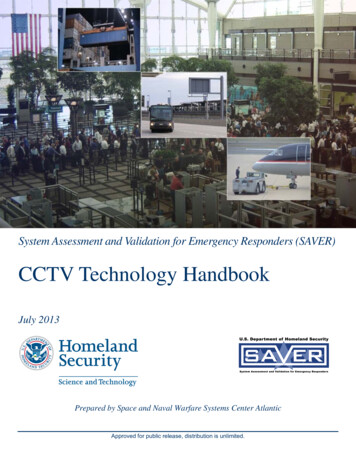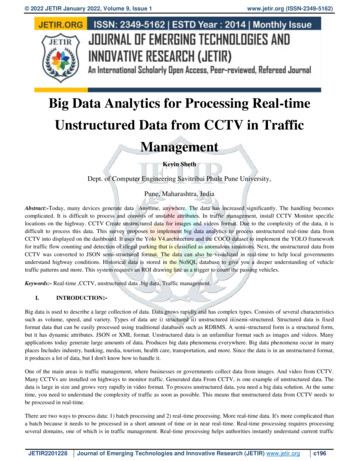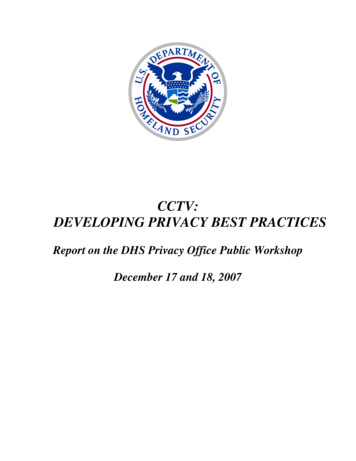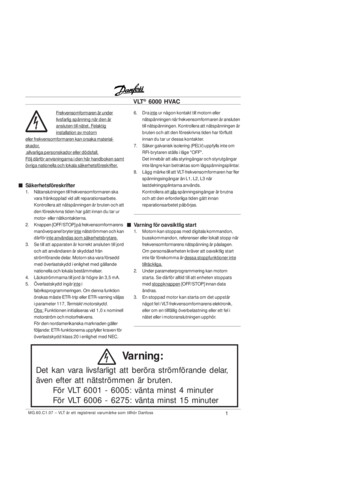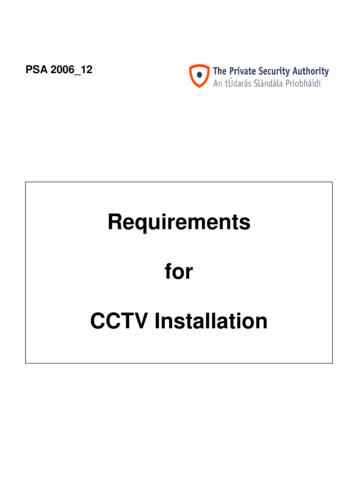
Transcription
PSA 2006 12RequirementsforCCTV Installation
Table of ContentsPage No.1. Introduction .32. Normative References .33. Definitions .44. Overview .65. Location Survey .66. System Design .67. System design proposal.98. Installation Planning .9Manufacturer’s recommendations.9Environmental considerations .99. CCTV Installation .9Competence.910. Test and Commission.10Inspection .10Functional testing .1011. As Fitted Document .1012. Maintenance .101
AppendicesAppendix 1 Flow Chart of CCTV installations .12Appendix 2 (Informative) Operational Requirements For CCTV Systems .13Appendix 3 Information to be included in Systems Design Proposal.14Appendix 4 (Informative) Sample Layout for System Design Proposal .16Appendix 5 (Informative) Checklist for CCTV Installation. .17Appendix 6 Record of Maintenance. .192
1. IntroductionThe objective of this document is to provide a reference against which Installers of CCTVsystems, whether analogue, digital or a combination of these technologies, can be inspected toensure that the functions and performance of CCTV systems installed by them are within levelsagreed by the licensed contractor and the client or user of the CCTV system during the SystemDesign phase of the process.This document is not a technical reference but sets out the PSA licensing requirements for theinstallation of CCTV systems. Its function is to facilitate the licensing process for CCTV installersby the Private Security Authority. It is a companion document to the Standard Recommendation40 (SR40) and any provision, paragraph, clause or sentence within SR40 that is in conflict withthis document shall be disregarded.This document has been prepared by the Private Security Authority in consultation withrepresentatives from the private security industry and An Garda Síochána. This document maybe an interim measure which will be used to underpin the licensing of installers of CCTVsystems. When an agreed standard becomes available which is adopted nationally, thisdocument may be superseded and replaced by that standard for CCTV installation.This is a working document and is subject to alteration or withdrawal in consultation with therelevant private security industry stakeholders at the discretion of the Private Security Authority.2. Normative ReferencesThis document incorporates provisions and extracts from other publications as follows by kindpermission of the National Standards Authority of Ireland:I.S. EN 50131-1, Alarm systems – Intrusion systems – Part 1 General requirementsI.S. CLC/TS 50131-7, Alarm systems – Intrusion systems – Part 7 Application GuidelinesI.S. EN 50132, Alarm systems – CCTV surveillance for use in security applications.3
3. DefinitionsCCTV system: A system consisting of electronic or other devices designed constructed oradapted to monitor or record images on or in the vicinity of premises.CCTV surveillance installation (installation): An installation consisting of the hardware andsoftware components of a CCTV system, fully installed and operational for monitoring on or inthe vicinity of premises.CCTV camera (camera): A unit containing an imaging device producing a video signal from anoptical image.CCTV camera equipment: A unit containing a CCTV camera plus appropriate lens andnecessary ancillary equipment.camera housing: An enclosure to provide physical and/or environmental protection of thecamera, lens and ancillary equipment.client: The purchaser of the CCTV system or representative(s) of the purchaser appointed forthe purpose of purchasing the CCTV system.data: image, meta and other data of the CCTV system.documentation: paperwork (or other media) prepared during the design, installation and handover of the CCTV system, recording details of the CCTV system, including paperwork (or othermedia) related to maintenance (where applicable).event: incident in the real world.EXAMPLE: A fire (burning house), an intrusion (broken door) or moving person, a power failure, a short circuit, an intruder passing into or intothe vicinity of a premises.export: transfer of data from the original location to a secondary storage location with aminimum of necessary changes.fault condition: condition of the system which prevents the CCTV system or parts thereoffunctioning normally.frame rate: numbers of frames per second.illumination: level of illumination on the area to be kept under surveillance.image: visible representation of a frame as a rectangular grid of pixels.interconnections: means by which messages and/or signals are transmitted between CCTVsystem components.lens: an optical device for projecting an image of a desired scene on to the photo-sensitivesurface of the imaging device.notification: passing an alarm or a message of the CCTV system to an external system.4
operator: authorised individual (a user) using a CCTV system for its intended purpose.response: every control command, change of system conditions or information to externaldevices or persons driven by alarms, faults, messages or triggers.risk: potential negative impact to an asset or value that may arise from some future eventrespecting the probability of loss.surveillance: observation or inspection of persons or premises for security purposes throughalarm systems, CCTV systems, or other monitoring methods.system components: individual items of equipment which make up a CCTV system whenconfigured together.Uninterrupted Power Supply (UPS): A device that provides battery backup in the event thatthe primary power source to an electrical system is interrupted, fails or falls below a level ofpower which is required for the operation of the electrical system in question. The UPS systemmay provide backup power for a period of minutes or several ritsintendedpurpose.
4. Overview4.1 There is no theoretical limit to the number of cameras and monitors which may be used in aCCTV installation but, in practice, this will be limited by the efficient combination of control anddisplay equipment and the operators’ ability to manage the system. The process flow chart atAppendix 1, sets out the process flow from location survey through to commissioning andhandover of the CCTV System.5. Location Survey5.1 The criteria above will be determined by a location survey of the site where the CCTVsystem is to be installed. This location survey shall also take account of the following:a)b)c)d)RiskContentsBuildingSupervision levels5.2 The location survey shall have, at least, sufficient detail to address the securityrequirements of the client and shall lead to a site plan being prepared with the optimalpositioning points for cameras being indicated on the site plan. The purpose of the locationsurvey and site plan is to identify the best placings for cameras, the direction of natural light,potential and actual environmental problems.6. System Design6.1 The objectives of the system design stage are to determine the extent of the CCTV system;select the appropriate equipment and to prepare a system design proposal. The system designshall also be informed by the client’s and/or user’s requirements as to the purpose of thecamera images.6.2 Where the objective of the CCTV system design is solely for the purposes of observingimages of persons or where this is among the objectives of the system design there is arelationship between the operator task and the size of the target (person) on the screen (seeAppendix 2 under Level of Quality). If the target is a person and the CCTV system has aninstalled limiting resolution of better than 400 tv lines, the minimum sizes of the target1 shall be:(i) for identification the target shall represent not less that 120% of screen height.(ii) for recognition the target shall represent not less than 50% of screen height.(iii) for detection the target shall represent not less than 10% of the picture height.(iv) for monitoring (e.g. crowd control) the target shall represent not less than 5% of thepicture height.1An illustrative example of this would be a 10 inch or 25.4 cm monitor screen. For monitoring the target shall take up at least5% of the screen height available (i.e. at least ½ inch or 1.27 cm of the screen height in this example). For detection the targetshall take up at least 10% of the screen height available (i.e. at least 1 inch or 2.54 cm of the screen height in this example). Forrecognition the target shall take up at least 50% of the screen height available (i.e. at least 5 inches or 12.7 cm of the screenheight in this example). For identification the target shall require at least 120% of the screen height available (i.e. at least a 12inch or 30.48 cm screen to view the entire target in this example).6
Where digital CCTV technology is used and the intended target is a person or persons theequivalent level of quality shall apply.10%50%100%Figure 1 - Graphic Example of Clause 6.2 requirements6.3 When designing the system, installers shall conduct a risk assessment to determine the risklevel and shall also design the system paying attention to the function of the observation orsurveillance as described by the client and/or user. The function of the observation orsurveillance can include:crowd controltheftunauthorised entry7
6.4 When designing a CCTV surveillance installation, the following criteria shall be taken intoaccount under the headings Operational Requirements and documented in an easilyunderstood and clear format:Operational Requirementsa) Purpose(s) of the surveillance.b) Potential threat or activity to be monitored and/or recorded.c) Determination of the zones or objects requiring surveillance.d) Determination of the number of cameras, and their locations, required to monitor theagreed zones and objects.e) Intended target(s) of the surveillance and the frame rate appropriate to the target’s speedwithin the location under surveillance.f) Response required on detection of an event.g) Manner in which images will be viewed and recorded.h) How data will be exported from the system to permanent record.i) Individuals who will require access to the recorded data.j) Selection of cameras and equipment depending on the operating environmentalconditions.k) Control centre configuration including secure location of control equipment.l) Power supplies; the use of a mini UPS System should be considered in situations wherethere is no UPS in place.m) Functional and operating procedures.n) Maintenance and repair.o) Evaluation of existing lighting and consideration of new or additional illuminationincluding the use of Infra Red cameras or lamps.p) Image resolution required.q) Determination of the most appropriate transmission method to be utilised.r) Compression technique to be used in recording (where appropriate).6.5 The system design shall reflect the client’s and/or user’s instructions or requests regardingthe system requirements including, where required, alert function(s)2, display3, recording4 andexport/archive.6.6 An operational requirements form shall be completed for each camera in a CCTV Systeminstallation as set out in Appendix 2. Where cameras have identical operational requirementsthey may be grouped together on one form, providing the camera reference and location areincluded for each camera.6.7 Where a CCTV system is installed and integrated with detectors (see 2. Detectors inAppendix 5) the following requirements shall be adhered to:6.7.1Detectors shall be installed in accordance with the requirements of I.S. EN 50131-1, asapplicable. Manufacturer’s recommendations shall be complied with in the installationof cameras using video detection.6.7.2The range of any detector shall not be greater than the field of view of any associatedcamera.6.7.3The range of any detector should not cover any area outside of the site or location.2e.g. Audible alarm, visual alarm, text message or image.e.g. No of screens required, number of cameras per display screen, type of display.4Duration of retention of images before being overwritten. Desired image quality of recorded image. Any additionalinformation to be recorded with the image.38
6.7.46.7.5The position of any detector shall be chosen so that it is not adversely affected by therising or setting of the sun.Multiple detectors shall not be connected to a single input unless individually identifiedby the CCTV control equipment.6.8 Where the location survey and system design documentation demonstrates that additionallighting is required and where this has been advised to, and agreed with, the client and/or user,the installation of such lighting shall be sufficient to illuminate the fields of view of each camera.The replacement of lighting shall be carried out in accordance with the manufacturer’srequirements.7. System Design Proposal7.1 A System Design Proposal shall be prepared for submission to the client. The proposal shallinclude the information detailed in Appendix 3. A sample System Design Proposal is included atAppendix 4.7.2 The System Design Proposal may be subject to alteration at other stages in theimplementation of the system. Any such changes shall be agreed between the licensedcontractor and the client and/or user. In these cases the documentation shall be amendedaccordingly.8. Installation PlanningPrior to commencing the installation of the components of the CCTV system, the followingissues shall be considered.8.1 Manufacturer’s recommendationsAll system components shall be installed in accordance with the manufacturer’srecommendations. If installation of a component in accordance with the manufacturer’srecommendations is not possible, advice should be sought from the manufacturer or supplier.8.2 Environmental considerationsSystem components shall be suitable for the environmental conditions in which they are tooperate. Examples of environmental considerations include potential impact of changes infoliage from season to season, potential impact of daily and seasonal variations in light andclimatic conditions.9. CCTV Installation9.1 Competence9.1.1 The installation shall be carried out by installers with the necessary training andexperience. Installers shall have the appropriate tools and test equipment necessary toinstall the CCTV system correctly. Where measuring equipment is used, the equipmentmust be of a standard necessary to provide the required precision and accuracy to installand test the system.9
9.1.2 Prior to commencing work all relevant health and safety requirements shall be considered.These will vary with the nature of the premises and may involve special installationequipment when working in hazardous areas.9.1.3 Electrical installation methods shall comply with current national and site regulations andthe electrical installation shall be carried out by technicians who are qualified to theappropriate level.10. Test and Commission10.1 InspectionAn inspection of the system shall be carried out and documented on completion of theinstallation of the CCTV system to confirm that the CCTV system has been installed inaccordance with the System Design Proposal. Any deviations shall be recorded for inclusion inthe As Fitted Document. A sample Inspection Checklist is included at Appendix 5.10.2 Functional testingThe CCTV system shall be tested and compared with the requirements included in the SystemDesign Proposal as amended by the As Fitted Document.11. As Fitted DocumentA document shall be prepared, based upon the System Design Proposal, amended to reflectany changes to the CCTV design found to be necessary during the installation process. The AsFitted Document shall be an accurate record of the installed CCTV system including anyinformation relating to the equipment installed and its location. A signed and dated copy of theAs Fitted Document shall be given to the client after satisfactory completion of inspection andtesting.12. MaintenanceRegular preventative maintenance or servicing should be carried out to ensure that the CCTVsystem performs to the same level as pertained at the time of commissioning and hand-over ofthe system.12.1 Maintenance, servicing and repair of CCTV systems shall only be carried out by acontractor in possession of a current, valid CCTV Installer's licence issued by the PSA.12.2 It is the client’s responsibility to arrange for the CCTV system to be properly maintained(inspected and serviced) and repaired as scheduled or necessary. A documentedarrangement should be made between the client and a licensed company for the repairand maintenance of the CCTV system. The arrangements shall specify the schedule ofmaintenance agreed including: the frequency of maintenance required, whether the maintenance is undertaken remotely or on-site, and the requirements of such maintenance10
Preventative maintenance shall include the items contained in Appendix 6 of thisdocument. The client shall be informed, in writing, of the date the maintenance was carriedout and the identity of the person who carried out the maintenance.12.3 Where any on-site maintenance is carried out, a documented record shall be signed by themaintenance technician/engineer and the client and/or user. Where any agreed remotemaintenance is undertaken, the maintenance technician/engineer shall supply the clientand/or user with details of the maintenance undertaken.12.4 Where the person carries out agreed corrective or responsive maintenance, the client shallreceive, in writing, a document outlining the fault condition requiring correction or repair, the actions taken to remedy the fault condition, and an undertaking that the system has been returned to the operational statuspertaining before the fault condition occurred.12.5 Modifications made to the CCTV installation or its configuration, shall be documented andnotified in writing to the client and/or user and an inspection test shall be carried out on therelevant components or parts of the system.11
Appendix 1Flow Chart ofCCTV installationsLocationSurvey/Site PlanInstallationPlanningSystem DesignCCTV InstallationSystem DesignProposal DocumentTest andCommissionAs FittedDocument12
Appendix 2 (Informative)OPERATIONAL REQUIREMENTS FOR CCTV SYSTEMS1N.B. This Form should be filled out for each camera prior to installation. For cameras with identicaloperational requirements see footnote below.Client Name:Details of CCTV System Contractor:Address:Name:Address:Supervised Area (if different from above):Name:Address:Telephone No.Fax No.Telephone No.E-Mail:Fax No.Job Reference No.:E-Mail:Camera Reference(s)Camera Location(s)Target(s) to beobservedActivity or activities tobe observedPurpose of observationSupply of images toGardaíLevel of QualityTick BoxWhat Response isneeded to event oractivity1. IdentificationExpectations from recordingTick BoxPrevention2. RecognitionDetection3. DetectAnalysis of Risk Levels4. MonitorManagementInformationEvidential5. Number PlateRecording6. Other (give details)Duration of Retentionof Recorded Images onhard drive.Other (give details)1Where cameras have identical operational requirements they may be grouped together on one form, providing thecamera reference and location as above are included for each camera. If required, a separate sheet attached to theform above may be used to record these details.13
Appendix 3Information to be included in the System Design ProposalA system design proposal shall be prepared for the attention of the client or specifier (or his/heragent) of the CCTV system. The proposal shall include all the information necessary to enablethe client or specifier to ensure the CCTV system is appropriate for the application. Theinformation provided in the proposal shall include the following.Client detailsThe name, address and the trading name (if different from the name of the client) and any otherinformation necessary to clearly identify the clientContractor detailsThe name, address and trading name of the contractor (if a trading name is used) shall beincluded along with any other information necessary for the client to identify and/or contact thecontractor. Headed company stationery with contractor details is acceptable in this regard.Supervised area detailsThe name and address of the supervised area shall be included if different from the address ofthe client. This shall also include a description of the supervised area and an indication of whatthe area is used for.Schedule of equipmentA schedule of the type and location of operational equipment (in words and/or diagrammaticform) shall be included.NotificationDetails of the proposed notification equipment shall be included along with the name andcontact details of the remote monitoring station, in the event that the CCTV system is subject toremote monitoring.LegislationDetails of any claims of compliance of the system components to any local or Nationallegislation shall be included.StandardsDetails of any claims of compliance of the system components to any National or EuropeanStandards shall be included.Other regulationsDetails of any claims of compliance of systems components to any other regulations shall beincluded.CertificationDetails of any claims for certification of the system components shall be included.MaintenanceThe system design proposal shall include recommendations for the scheduled maintenance ofthe CCTV system or individual components including details of the frequency of anymaintenance visits and a list of the work to be carried out during each visit.14
Appendix 3 (cont'd)When serviced the CCTV system shall be inspected, tested and adjusted to ensure correctoperation in line with the functional requirements of the CCTV system as outlined in the AsFitted Document.Care should be taken to ensure that the equipment is properly reinstated after testing. Allmaintenance shall be carried out in reference to the manufacturer’s recommendations.RepairDetails of the proposed repair service to be provided including contact names and telephonenumbers.15
Appendix 4 (Informative)CCTV SYSTEMSSAMPLE LAYOUT FOR SYSTEM DESIGN PROPOSALClient Name:Details of CCTV System Contractor:Address:Name:Address:Supervised Area (if different from above):Name:Address:Telephone No.Fax No.Telephone No.E-Mail:Fax No.Job Reference No.:E-Mail:Schedule of Equipment:(A schedule of the type and location of operational equipment. This may be supplemented by a diagrammatic layout of the operationalequipment. A continuation sheet may be used as and if required.)Operational Monitor, Detect, Recognise,Description:Manufacturer:Product Ref.:Identify, Record)Certification(Details of any claims for certification of the system componentsshall be included.)Notification:Details of proposed notification equipment shall be included alongwith the name and contact details of the remote monitoring station,in the event that the CCTV system is subject to remote monitoring.Intervention:(Planned response to faults during the operation of the systemshall be detailed.)Legislation: (Details of any claims of compliance of the systemcomponents to any local or National legislation shall be included.)Maintenance:(A maintenance Contract/Agreement will be offered on completionof the CCTV System installation.)Standards: (Details of any claims of compliance of the systemcomponents to National or European Standards shall be included.)Repair:(Details of the proposed repair service to be provided includingcontact names and telephone numbers.)Other Regulations:(Details of any claims of compliance of the system components toany other regulations shall be included.)Signed on behalf of CCTV System Contractor:Date:Signed on behalf of the Client:Date:(Note: Two signed copies required; one for installer and one to be retained by the client.)16
Appendix 5 (Informative)Checklist for CCTV Installation1. Customer Needs and Requests System design addresses risks and meets customer’s overall needs.Products used meet the system features that customer requested.COMMENTS:2. Detectors Installed to manufacturer’s installation instructions.Cover only within site boundaries (i.e. does not cover public areas).Each detector uniquely identifiable to the system.All cabling and detection devices incorporate tamper protection.PIRs are not easily subject to false triggering (where installed).COMMENTS:3. Positioning and Configuration of Cameras Camera’s field of view covers areas of associated detectors.Cameras do not face directly into sun or light.Cameras do not overlook public places.Camera type (e.g. PTZ, fixed, etc) is appropriate for the position and use.COMMENTS:System Performance and Integrity17
4. System Performance, Management and Integrity Appropriate level of training and/or demonstration given to customer.Appropriate signage in place.System management procedures documentation given to customer.Probable application of Data Protection Act communicated to customer.Back-up UPS installed where requested or appropriate.Event log-system history is held and retained in secure method.Recording settings and duration of retention of recorded images documented.Indication of video loss, tampering and failure can be properly conveyed to remotecentre, where it exists.COMMENTS:5. Testing and Commissioning Tests carried out on:ooooo DetectorsCamerasAccuracy of recorded dataComparison of reference images against live operationsWalk Test (for each camera)Results of testing documented and given to customer.6. MaintenanceClient/Owner/User provided with system spec including equipment inventory.Setting/Unsetting device installed and tested.Client/User informed of any inspection and servicing routines.COMMENTS:Installers Signature:Company/Trading Name:Date Installation Completed:Client/Owner/User Signature:18
APPENDIX 6RECORD OF MAINTENANCECLIENT’S NAME AND ADDRESS:MAINTENANCE DUE ON:DATE MAINTENANCE CARRIED OUT:MAINTENANCE CARRIED OUT BY:I CERTIFY THAT I HAVE CARRIED OUT THE FOLLOWING MAINTENACE ON THE CCTV SYSTEMLOCATED AT ON THE DATE ABOVE: System History since last maintenance visit checkedSigns of deterioration or damage checked for, through visual inspection.Cameras, lenses and housing checked and cleaned.Remote signalling equipment (where fitted) checked and tested.Recording and playback quality checkedLenses and pictures checked for correct field of view and adjusted (if necessary)All CCTV control equipment (e.g. monitors, multiplexers, DVR, etc) checked.Transmission of images to remote centre checked (where applicable)All test results logged and available for inspectionCCTV system returned to operational status (date and time conveyed to client)Additional Comments (if required)Signature of Maintenance Operative:Date:Signature of Client:19
CCTV installation but, in practice, this will be limited by the efficient combination of control and display equipment and the operators' ability to manage the system. The process flow chart at Appendix 1, sets out the process flow from location survey through to commissioning and handover of the CCTV System. 5. Location Survey







